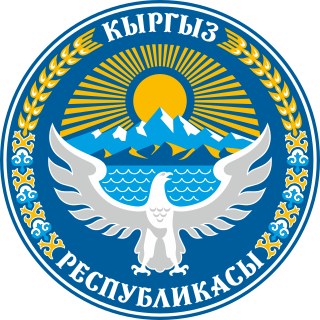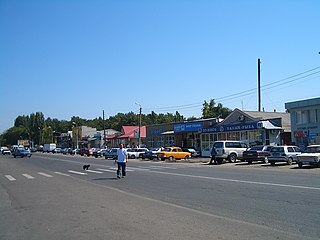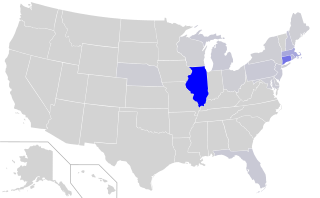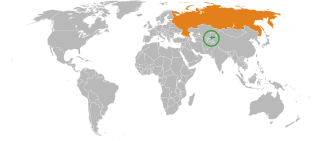Related Research Articles

Bishkek, formerly known as Frunze, and earlier Pishpek, is the capital and largest city of Kyrgyzstan. Bishkek is also the administrative centre of the Chüy Region. Bishkek is situated near the border with Kazakhstan and has a population of 1,074,075, as of 2021.

Kyrgyzstan has close relations with other members of the Commonwealth of Independent States, particularly Kazakhstan and Russia, given the historical legacy of the Soviet Union. It also has close relations with Turkey as well, given their shared heritage as Turkic languages.

The Kyrgyz people are a Turkic ethnic group native to Central Asia. They primarily reside in Kyrgyzstan, Uzbekistan, and China. A Kyrgyz diaspora is also found in Russia, Tajikistan, and Kazakhstan. They speak the Kyrgyz language, which is the official language of Kyrgyzstan.

Asian Americans are Americans with ancestry from the continent of Asia.

Kyrgyzstan, officially the Kyrgyz Republic, is a landlocked country in Central Asia, lying in the Tian Shan and Pamir mountain ranges. Bishkek is the capital and largest city. Kyrgyzstan is bordered by Kazakhstan to the north, Uzbekistan to the west, Tajikistan to the south, and China to the east and southeast. Ethnic Kyrgyz make up the majority of the country's over 7 million people, followed by significant minorities of Uzbeks and Russians.
The term model minority refers to a minority group, defined by factors such as ethnicity, race, or religion, whose members are perceived to be achieving a higher socioeconomic status in comparison to the overall population average. Consequently, these groups are often regarded as a role model or reference group for comparison to external groups (outgroups). This success is typically assessed through metrics including educational attainment, representation within managerial and professional occupations, household income, and various other socioeconomic indicators such as criminal activity and strong family and marital stability. The prominent association of the model minority concept is with Asian Americans within the United States. Additionally, analogous concepts of classism have been observed in numerous European countries, leading to the stereotyping of specific ethnic groups.

The demographics of Chicago show that it is a very large, and ethnically and culturally diverse metropolis. It is the third largest city and metropolitan area in the United States by population. Chicago was home to over 2.7 million people in 2020, accounting for over 25% of the population in the Chicago metropolitan area, home to approximately 9.6 million.

Kant is a town in the Chüy Valley of northern Kyrgyzstan, some 20 kilometres (12 mi) east of Bishkek. It is the administrative center of the Ysyk-Ata District. Its population was 22,617 in 2021. Kant was established in 1928.
Sri Lankan Americans are Americans of full or partial Sri Lankan ancestry. Sri Lankan Americans are persons of Sri Lankan origin from various Sri Lankan ethnic backgrounds. The people are classified as South Asian in origin.

Lithuanian Americans refer to American citizens and residents of Lithuanian descent or were born in Lithuania.

Kurds in the United States refers to people born in or residing in the United States of Kurdish origin or those considered to be ethnic Kurds.

Overseas Pakistanis, or the Pakistani diaspora, refer to Pakistanis who live outside of Pakistan. These include citizens who have migrated to another country as well as people born abroad of Pakistani descent. According to a December 2017 estimate by the Ministry of Overseas Pakistanis and Human Resource Development, approximately 8.8 million Pakistanis live abroad. Data released in 2023 by the Ministry of Emigration and Overseas Employment states that more than 10.80 million people have moved abroad since 1990.

Kyrgyzstan–Russia relations are the relations between the two countries, Kyrgyzstan and Russia. Russia has an embassy in Bishkek and a consulate in Osh, and Kyrgyzstan has an embassy in Moscow, a consulate in Ekaterinburg, and a vice-consulate in Novosibirsk.

The Azerbaijani diaspora are the communities of Azerbaijanis living outside the places of their ethnic origin: Azerbaijan and the Iranian region of Azerbaijan. Total number of the Azerbaijani disapora varies by sources, however, at least 5–10 million Azeris live outside of Iran and Azerbaijan.
There is a population of Uyghurs in Kyrgyzstan, who mostly came to the country in three separate migrations throughout the 19th and 20th centuries. According to official statistics, they make up about 0.9% of the national population.

Overseas Indians, officially Non-Resident Indians (NRIs) and People of Indian Origin (PIOs) are Indians who reside or originate outside of India, Bangladesh, Pakistan and Sri Lanka. According to the Government of India, Non-Resident Indians are citizens of India who currently are not living in India, while the term People of Indian Origin refers to people of Indian birth or ancestry who are citizens of countries other than India. Overseas Citizenship of India (OCI) is given to People of Indian Origin and to persons who are not People of Indian Origin but married to Indian citizen or People of Indian Origin. Persons with OCI status are known as Overseas Citizens of India (OCIs). The OCI status is a permanent visa for visiting India with a foreign passport.
Kazakh Americans are Americans of full or partial Kazakh ancestry. Although in the 1960s the population of Kazakh origin in United States was estimated at 30,030, the 2000 Census put the population size at less than 300. According to the American Community Survey of 2010–2012, there were more than 23,000 Kazakhstan-born people living in the United States, but not all of them were of Kazakh ethnicity.
Uzbek Americans are Americans of Uzbek descent as well as non-Uzbek former citizens of Uzbekistan. The community also includes those who have dual American and Uzbek citizenship.
Central Asian Americans are Americans with ancestry from Central Asia. They include Kazakh, Kyrgyz, Tajik, Turkmen, and Uzbek individuals. People of Afghan, Baloch, and Uyghur descent are also sometimes classified as Central Asians. Although previously not mentioned under any category, Central Asians are now categorized as Asian Americans as of 2024.
Central Asians in the United Kingdom are Central Asians living in the United Kingdom. They have been present in the country since the 21st century and primarily originate from the countries Kazakhstan, Kyrgyzstan, Tajikistan, Turkmenistan, and Uzbekistan.
References
- ↑ https://data.census.gov/table?t=-04&y=2020
- ↑ https://kg.akipress.org/news:2050622
- ↑ "Kyrgyz Communities in the United States: Beyond Myths and Stereotypes". Central Asian Bureau for Analytical Reporting. Retrieved 4 February 2023.
- ↑ "Kyrgyz Families Take Illegal Route Through Mexico In Pursuit Of 'American Dream'". Radio Free Europe / Radio Liberty. Retrieved 4 February 2023.
- ↑ "Explore Census Data". data.census.gov. Retrieved 2025-01-27.
- ↑ "Kyrgyzstan's Diaspora: An evening of Music and Conversation". Eurasianet. Retrieved 4 February 2023.
- ↑ "Kyrgyz Communities in the United States: Beyond Myths and Stereotypes". Central Asian Bureau for Analytical Reporting. Retrieved 4 February 2023.
- ↑ "Explore Census Data". data.census.gov. Retrieved 2025-01-27.
- ↑ "Mission". Kyrgyz American Foundation.
- ↑ "Kyrgyz Communities in the United States: Beyond Myths and Stereotypes". Central Asian Bureau for Analytical Reporting.

